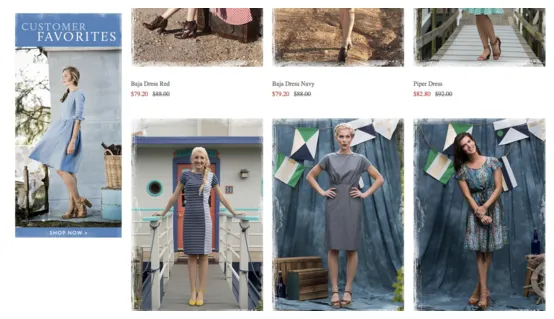Table of contents
When e-commerce merchants talk about cross-selling and upselling online customers, their ultimate goal is to increase their average order value (AOV). Just like it sounds, average order value is the average of your store’s typical order price.
Every online store has high-price purchasers and those who only come when there is a sale. For successful businesses looking to effectively scale, increasing your site’s average order value is key. After all, when average order value increases, your cost of acquisition per customer (CAC) decreases. Then you can spend more time on decreasing customer churn. Overall, addressing these three issues (AOV, CAC, and churn) creates a stable revenue stream, by which you can forecast years out and better strategize overall company goals and initiatives.
So, let’s talk about using cross-selling and upselling to increase AOV.
Navigation and online search
On-site search is a key contributor to the success of almost any e-commerce business, but it is often deprioritized. On-site search, if done well, can lead to higher conversions and increased average order value for any online retailer.
Why is that? Well, whenever customers use a highly specific search phrase, they’re likely searching for the exact product they intend to buy. In other words, shoppers utilizing your on-site search are further down your conversion funnel than those shoppers simply browsing your site. Since these shoppers are at an advanced stage of the buying process, ensuring that your search feature helps them find the products they’re searching for should be a high priority.
Here are a few best practices and must-have features to think through as you revisit your on-site search strategy.
Rich autocomplete
Rich autocomplete, also known as autosuggest or predictive search, is an on-site search functionality that allows retailers to guide their customers to matching products as they type. This functionality significantly enhances the shopping experience on your site, helping your customers save time and eliminate spelling errors.
Today’s advanced autocomplete technology takes this several steps further, providing retailers with a range of merchandising opportunities right in the search box, such as:
- Including thumbnail images, prices, ratings, and other relevant information with the product matches, which encourages shoppers to skip the search results page and navigate directly to the product they desire
- Using banners to display special offers and promotions
- Displaying the most popular products high in the results to drive increased conversions
- Showing a list of popular searches, which saves time and eliminates spelling errors and confusion over the terminology used on your site
“Autocomplete is the best way to display search results to ready-to-buy customers,” says Ryan Urban, director of acquisition for online store Brickhouse Security.
For an example of how this works on a site, check out Chuck Levin’s search bar.
Keyword-triggered banners
What if you could choose which banner to display to shoppers based on their search query? Keyword-triggered banners give you this power.
Well-targeted, keyword-triggered banners are a simple way of ensuring customers are engaged with and visually stimulated by your site on a personalized level. Your site search analytics can give you a wealth of data about which banners to create to generate successful campaigns.
Here are some examples of how successful retailers have used them:
Shabby Apple uses sidebar banners to push curated collections.
- To promote a specific brand
- To display a special holiday promotion
- To cross-sell or upsell
- To offer discounts or free shipping to certain types of shoppers
When clicked, banners can also direct shoppers to highly targeted landing pages, like the example above. These pages might include all products from a specific manufacturer, a group of products related to a holiday or seasonal theme, or anything else that makes sense for your store.
Product recommendations are about optimizing those customers already on your site and looking to purchase. Product recommendations market to shoppers on a one-to-one basis and offer a more personalized shopping experience relevant to the tastes and interests of each individual person. Using product recommendations to increase AOV and customer loyalty, as opposed to spending money on advertising to increase site traffic, allows you to reduce marketing spend and provide a quick, and relatively permanent, remedy to increase cash flow.
Below are three ways to improve the integration of product recommendations on your online store to drive real business results and increase customer satisfaction.
Personalized product recommendations
Product recommendations are about optimizing those customers already on your site and looking to purchase. Product recommendations market to shoppers on a one-to-one basis and offer a more personalized shopping experience relevant to the tastes and interests of each individual person. Using product recommendations to increase AOV and customer loyalty, as opposed to spending money on advertising to increase site traffic, allows you to reduce marketing spend and provide a quick, and relatively permanent, remedy to increase cash flow.
Below are three ways to improve the integration of product recommendations on your online store to drive real business results and increase customer satisfaction.
1. Limit your product recommendations
Avoid cluttering the user experience and take an organized approach to recommendations. Quantity does not mean quality. Instead, focus on a small set of product recommendations that are highly relevant to the visitor.
Let’s look at an example here. Online retailer Chuck Levin’s utilizes product recommendations to increase AOV per customer. After you visit a few product pages on its website for acoustic guitars, the site will show you a “You Might Also Like” suggestion box. Highly relevant to the visitor’s initial search and browsing behavior, the website presents only a few highly similar products in varying colors.
2. Focus your product recommendations on complementary items
Offering complementary product recommendations on each product page is the most successful approach to increase your AOV. By recommending the top parallel components that go with each main item, you’ll improve your ability to drive larger transactions. Customers usually respond well when presented with this type of specific offer as they often don’t know exactly what they want or need beyond the main product, and are looking for help finalizing their product selection.
CasinoSupply.com has successfully increased its average order value by recommending complementary products as visitors add products to their carts. In effect, Casino Supply is asking its customers, “would you like fries and a drink with that?”
3. Consider a “complete the look” feature
“Complete the Look” is an additional strategy to leverage product recommendations to increase average order value. These recommendations are more category based (versus behavior based), which is an easier approach for many retailers since it means that they can rely on their own experience to make effective recommendations.
An example of a site that is leveraging the power of product recommendations with a “complete the look” strategy is ASOS. The international retailer pays particular attention to the details of what their customers are searching for and putting in their carts. The site’s “Shop the Look” button quickly matches customers to complementary products sold by ASOS. As seen in the example below, the company recommends shoes and accessories to complement a dress in the shopper’s cart.
In all, the use of product recommendations and on-site search will only increase a customer’s propensity to buy. If you get it right, shoppers will walk away with more items in their baskets, generating higher revenue for you as a retailer.
![]()















